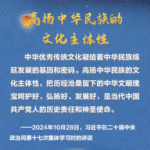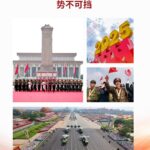Advancing Cultural Progress Through Continuous Inheritance – A Series Review on the Lively Practice of Cultural Thought
Five thousand years of uninterrupted heritage, the river of civilization flows majestically; over a century of turbulent changes, national rejuvenation becomes unstoppable.
In this new era and journey, how can we promote civilizational renewal and create new forms of human civilization based on over five thousand years of Chinese civilization? How can we achieve civilizational revival and cultural progress within the historical tide of national rejuvenation?
In October 2023, the cultural thought was formally proposed at the National Conference on Propaganda and Ideological Culture. Guided by this cultural thought, the Communist Party of China leads the Chinese people in strengthening historical and cultural confidence, adhering to the “Two Combinations,” advancing cultural creation while continuing historical context, promoting cultural progress while inheriting Chinese civilization, endowing national rejuvenation with deeper cultural connotations and broader civilizational dimensions, and gathering stronger Chinese spirit, Chinese values, and Chinese strength.
Strengthening the Cultural Foundation of National Rejuvenation
In May 2025, the General Secretary inspected the Longmen Grottoes in Luoyang, Henan. By the Yi River, the General Secretary gazed at history while looking toward the future: “We must protect, inherit, and spread these treasures of Chinese culture well.”
From Liuchang Lane to White Horse Temple, from Zhaoxing Dong Village to Lijiang Ancient Town, pausing in contemplation before the He Zun vessel at the Baoji Bronze Museum, visiting the exhibition of excavated Qin and Han bamboo slips at Yunmeng County Museum in Xiaogan… The General Secretary’s cultural footprints span the entire nation, measuring civilization with steps, connecting ancient and modern with thought, strengthening the cultural foundation from “Why China” to “Why Rejuvenation.”
“Coming from the inheritance of over five thousand years of Chinese civilization, the two characters ‘China’ are engraved at the bottom of the ‘He Zun’ vessel and inscribed in the hearts of every Chinese descendant,” the General Secretary emotionally reflected in the 2025 New Year address.
Cultural confidence comes from distant history. Chinese civilization stands in the world with its outstanding continuity, innovation, unity, inclusiveness, and peacefulness. Despite changing circumstances, this river of civilization continues to flow unceasingly.
As the General Secretary pointed out, Chinese civilization has endured for thousands of years and remained long-lasting despite numerous hardships. This is a miracle of human civilization and the foundation of our confidence.
The “Beijing Central Axis” was included in the World Heritage List, historical features vividly reappeared, living environments and urban landscapes continuously improved, and citizens’ sense of gain and happiness kept increasing; the successful inscription of “Spring Festival” as intangible cultural heritage made Chinese New Year a “World Year,” allowing people to deeply experience how the Chinese nation’s cultural identity and patriotic spiritual bonds promote Chinese descendants to form a tightly united strong community…
In the continuous inheritance of Chinese cultural context, the cultural subjectivity of the Chinese nation becomes more distinct, constantly awakening cultural consciousness, shaping cultural confidence, forging cultural independence, and achieving cultural strength, thereby transforming into firm actions to protect civilization.
During the “14th Five-Year Plan” period, China basically completed the inventory of cultural relic resources, achieved important phased results in the fourth national cultural relics survey, with over 130,000 newly discovered cultural relics; the Chinese Civilization Exploration Project proposed Chinese solutions for defining civilization and identifying civilized society, making original contributions to world civilization origin research.
Advancing forward while continuing the national cultural bloodline, the cultural foundation for national and ethnic development becomes deeper and more solid.
“Achieving national rejuvenation is an unprecedented great undertaking. Both aspirations and challenges inspire us with a spirit of seizing the day and never slackening,” the General Secretary’s important speech at the reception celebrating the 76th anniversary of the People’s Republic of China was inspiring.
Today, the Chinese people possess stronger motivation to advance, more elevated spirit of struggle, and firmer belief in victory, radiating unprecedented historical initiative and creative spirit.
Stimulating Innovative Vitality for Civilizational Progress
During the 2025 National Day and Mid-Autumn Festival holiday, people traveled across mountains and rivers, pursuing their “poetry and distant places” under the dual festival radiance… In the flowing beautiful life scenes, unique “Chinese style” and “cultural flavor” overflowed, vividly demonstrating the vigorous vitality of Chinese culture bursting forth through inheritance and innovation.
Customs延续 for thousands of years evolve with the times while being “used daily without awareness,” cultures full of national essence and spirit combine with



